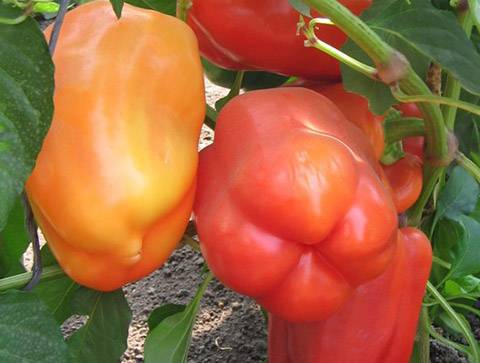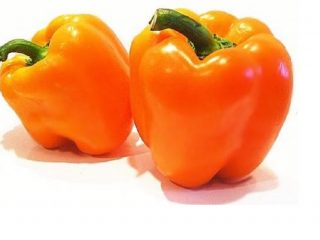Content
Sweet peppers are a member of the nightshade family and a “relative” of potatoes, eggplants and tomatoes, which imposes certain restrictions when growing these crops in one area. In particular, peppers should not be planted where nightshades grew last season. In addition to the depleted composition of the soil, pathogenic organisms remain in it that can harm pepper bushes.
Theoretically, there are four cultivated species of pepper. In practice, three of them are cultivated only in the countries of Central and South America, where these species grow well on their own in the wild. Only one type of pepper has become widespread throughout the world, from which both bitter and sweet varieties originate.
The walls of the pod are used as food for sweet peppers. It is the thickness of the walls, also called the pericarp, that determines the value and profitability of the variety. Fruits with a pericarp thickness of 6 mm or more are considered thick-walled.
Thick-walled varieties can be with large or medium fruits. Many large-fruited, thick-walled peppers have a cuboid shape.
The best varieties of large-fruited thick-walled peppers
Hercules
Mid-season, requiring three months from the moment of planting in a permanent place to fruiting. The fruits are large, red, and have a distinct cuboid shape. The size of the pod is 12x11 cm. The weight of the pepper can reach 350 g, the thickness of the pericarp is up to 1 cm. It tastes very sweet, regardless of whether it is picked green at technical ripeness or red, being fully ripe. Very productive.
The advantages include good keeping quality, versatility of use (suitable both fresh and for all types of preservation), resistance to common pepper diseases, good formation of ovaries at low temperatures.
Seeds are sown for seedlings at the end of March, in a permanent place they are planted at the end of May, and the harvest is harvested in August.
White gold
Particularly large-fruited, thick-walled pepper of Siberian selection. The fruits reach a weight of 450 g. The pericarp is up to 1 cm thick. Cuboid fruits of such gigantic sizes grow on a bush only 50 cm high.
To obtain a good harvest, bushes are planted at the rate of 5 plants per m². Feeding this variety with fertilizers is mandatory, since the plant requires a lot of nutrients to form large peppers.
Seeds for seedlings are sown at the end of March. After two months, the seedlings are planted in the ground. The variety is universal; it can be planted both in an open garden bed and in a greenhouse. The harvest begins in July and ends in August.
Siberian format
A new hybrid bred in Siberia. Belongs to the mid-season group. The bush is powerful, semi-standard, 80 cm high.
The fruits are large, cube-shaped, inside the pepper is divided into 3-4 chambers. Ripe red peppers. The usual size of the fruit is 12x10 cm.Pericarp thickness 1 cm.
With a fruit weight of 350-400 g declared by breeders, peppers can grow up to 18x12 cm and weigh half a kilogram. But such large sizes are achievable only in greenhouse conditions. Up to 15 fruits are formed on one bush, with a total weight of 3.5 kg.
The variety is demanding on soil composition and moisture. For high yields, it is necessary to follow the feeding and watering regime. On poorer soil, the variety can produce a good harvest, but the fruits will be small. 6 bushes are planted per square meter.
Of the minuses: seed germination is 70%.
Sun of Italy
A variety with a growing season of 4 months. The bush is not tall, only 50 cm. But the fruit of this variety is very large, with good care it reaches 600 g. The thickness of the pericarp is 7 mm. Grows in greenhouses and outdoors. In open beds, the size of the fruit is slightly smaller: up to 500 g. A variety for universal use. The delicate, aromatic pulp is suitable for salads, canning and cooking. Well suited for commercial cultivation.
Bel Goy
Late-ripening, with very large fruits, reaching a weight of 600 g. Suitable for growing in greenhouses and open ground. Therefore, it should be taken into account that large measurements of fruits and bushes are more likely to refer to greenhouse plants. In open ground, the size of the bush and peppers will be somewhat smaller.
The numbers found for a bush height of 150 cm refer to greenhouses, while the bush height of 120 cm refers to the height of a plant in open ground. Also, fruits in open ground are unlikely to grow to 600 g; the usual weight of pepper in an open garden is 500 g. Which is also a lot.
The variety is characterized by good ovary formation and consistently high yield.
Ural thick-walled
An early-ripening pepper hybrid specially bred for the northern regions. The hybrid forms giant fruits measuring 18 cm with a pericarp thickness of 10 mm. Ripe red peppers.
The manufacturer recommends this variety for growing in greenhouses and outdoors. Such properties add to the attractiveness of the hybrid, given that it is designed for cultivation in the rather harsh conditions of the Siberian region. In addition, the hybrid is resistant to major pepper diseases.
Queen F1
The hybrid matures in 110 days, producing dark red peppers. At the stage of technical ripeness, the peppers are green. Bush height up to 0.8 m, compact. The weight of one fruit is up to 200 g, the wall thickness is 1 cm. Up to 12 peppers can ripen on a bush at the same time. Hybrid yield up to 8 kg/m²
Blondie F1
Selected by the Swiss company Syngenta AG, which is one of the largest seed producers. It is declared as early ripening, but, given the country of origin, it is unlikely to be suitable for open ground in the northern regions of Russia.
The peppers are four-chambered and quite large. The weight of the pepper reaches 200 g, the thickness of the pericarp is 8 mm. Ripe peppers are golden yellow in color. The “green” fruit has a pale fawn color.
Among the advantages, there is resistance to viruses, to stressful weather conditions, and good formation of ovaries in hot conditions. A variety for universal use.
Denis F1
A popular variety that has proven itself for several years. Well suited for northern regions, as the growing season is only 90 days. The bush is 0.7 m high, resistant to tobacco mosaic. Can be grown indoors and outdoors.
Large-fruited.The red fruits have the shape of a parallelogram with dimensions of 18x10 cm. The pericarp is 9 mm. The weight of pepper declared by the manufacturer is 400 g.
Gardeners' observations of "Denis F1" over several years have shown that in a greenhouse the bush grows up to one meter and bears 6-7 fruits. Very interesting information came from gardeners regarding the weight of fruits. It is possible to achieve the fruit weight declared by the manufacturer if you leave only 3-4 ovaries on the bush and feed it weekly with universal fertilizers. A general pattern has been noticed: the more ovaries, the smaller the fruits. But whether to achieve large fruits with the help of fertilizers or to collect smaller peppers in larger quantities is up to the owner of the bush.
Some growing secrets
Experienced summer residents prefer to plant “Denis F1” under a film, which is removed with the onset of hot weather, since this variety can be too hot in greenhouses. But the statements about resistance to diseases are confirmed.
In general, agricultural technology is the same as for other varieties. Small nuances are that bushes of this variety are planted at a distance of 0.5 m from each other. Being large-fruited, the variety needs additional fertilizers, which must be added strictly according to the instructions so as not to “overfeed” the plants.
Growth stimulants are suitable for seedlings. Bushes planted in a permanent place are fertilized three times: 2 weeks after planting, during the formation of ovaries, and during the ripening period of the crop.
Atlant
A very mysterious variety, I must admit. A number of companies position it as a hybrid. Other companies describe it as varietal, that is, one from which you can leave seeds for next year.Apparently, you will have to find out whether a hybrid or variety has grown on your summer cottage experimentally. The growing season of this pepper also varies depending on the manufacturer, from super-early to mid-ripening.
However, the difference in ripening time may depend on what manufacturing companies mean by this. Thus, “early ripening” for a Siberian company will be “super-early ripening” for a southern company, and “mid-ripening” for southerners will be “early ripening” for northerners.
The variety of manufacturing companies of this variety also has its advantage. You can choose seeds adapted specifically to your climate zone.
General characteristics given by companies to pepper: large fruits, excellent taste and high stable yield.
In general, Atlant has positive reviews and is one of the best large-fruited, thick-walled varieties of peppers. The interest shown in it by farmers who grow peppers for sale also speaks in its favor.
The growing season for this variety is only 75 days. In this connection, it is classified as a super-early ripening variety.
The bushes are compact, so they are planted according to a 40x40 cm pattern. The variety is high-yielding, producing huge red fruits up to 22 cm long with a pericarp thickness of 10 mm. Fruit weight 150 g.
Some companies claim that the variety is resistant to diseases.
Some features
At Atlant, the seeds must be pickled in a solution of potassium permanganate before planting, since the producers do not treat the seeds.
When planting in a permanent place, it is better to treat the roots of the seedlings with a root growth stimulator.
The bushes do not require tying. But mandatory feeding is required during the growing season if you want to get large fruits.
If peppers are sent for storage, the fruits are removed after they acquire a green color. Otherwise, they are left to ripen on the bush.
In the northern regions, it is recommended to grow the variety in shelters made of non-woven material. In this case, the fruits ripen well on the bushes.
"Atlanta" is characterized by high productivity both in the open air and in greenhouses, and good keeping quality. Its taste is always excellent, regardless of the resulting size of the fruit and the place of cultivation.


















